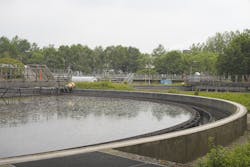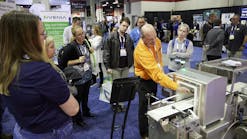Industries and municipalities should consider how to troubleshoot bacterial levels in wastewater treatment plants. Different steps must be taken to ensure that bacteria levels, including the microorganisms that help remove harmful contaminants, are properly controlled.
Know the influent untreated wastewater
Analyze the sources of wastewater entering the system. How strong is the influent wastewater? Are water conservation measures in place? How high is the organic loading entering the plant? Older wastewater treatment plants (WWTPs) may have been designed with minimal organic loading. Because of water conservation, certain newer WWTPs may be designed with higher organic loading. When operating an older plant, more diligent monitoring of the influent may be required to reduce the incoming organic material.
The sources, which can upset wastewater treatment, must be monitored. Monitor the influence of the biochemical oxygen demand (BOD), total suspended solids (TSS), metals, oil and grease, and other parameters.
In addition, supernatant from sludge processing, decant from digesters and scum return can contribute to high organic and hydraulic loads on the WWTP. Create clear operating procedures, and include accountability for violating those procedures. It is important to prepare and enforce operating procedures that address incoming abnormalities including chemicals, metals, and fats, oil and grease.
The effects of excessive inflow
Excessive inflow may affect the system by increasing the incoming volume and decreasing the organic load ( food supply for the plant’s microorganisms). Inspect for broken collection system lines, separated joints, poor seals or unauthorized waste sources entering the system.
Does the flow volume spike in the WWTP when certain conditions occur? If the incoming volume is high, it may be increasingly difficult to meet permit limits because the incoming untreated volume — and food supplies for the microorganisms — can become irregular.
Influent control
Incoming pumps are usually designed to pump peak flow (maybe greater than three times the daily average flow). Make sure the floats are adjusted properly so that incoming wastewater does not overwhelm the treatment plant. The following actions may help equalize the hydraulic loads entering the WWTP:
- Reduce the impeller size in each pump.
- Install one or more variable frequency drives.
- Install an influent pump with a smaller capacity.
- Adjust the pump settings and put timers on the pumps (with backup float control), or ensure that all incoming pumps do not start at the same time.
Maintain optimal solids
Maintaining optimal solids content in the aeration basin is required to prevent the microorganisms from dying or becoming unhealthy. Mixed liquor suspended solids (MLSS) contain bacteria and other microorganisms. Although the MLSS concentration in many types of WWTPs should be between 2,000 and 4,000 milligrams per liter (mg/l), the wastewater plant operator should run the system based on its particular design.
High MLSS in the aeration basin can result in low levels of dissolved oxygen (DO) and increase the discharge of solids to the disinfection area, receiving treatment plant or environmental stream, causing a bacteria permit limit overage and possibly violation of other parameters such as total suspended solids. DO should be at a minimum of 2 mg/l in the aeration basin to maintain healthy microorganisms.
Keep the weirs clean
Make certain that each overflow weir is clean and free of algae and solids. Below are some options for decreasing algae, sludge, grease and debris:
- Install brushes or washers on each solid separation process unit overflow weir.
- Block and divert discharge when cleaning the weirs to a screening device (sending the screened wastewater to the head of the plant).
- Set the scum return device properly to remove all floating debris.
- Install fine screens at the head of the plant to remove incoming debris.
- Keep healthy, appropriate types and ratios of microorganisms in the works to prevent bulking, denitrification and washout of solids.
- Spray the surface of the gravity separation process units with non-potable water to help settle surface solids.
- Clean the walls often to prevent solids from building up.
UV light systems
Ultraviolet (UV) light systems require proper design and maintenance to work efficiently. To ensure that the system is designed with adequate capacity and proper mixing, each approach and departure channel in the system should be greater than 3 feet long and unobstructed to prevent turbulence.
The type of bulb makes a difference in how effectively the UV treatment kills bacteria. Medium-pressure and high-pressure bulbs produce an abundance of wavelengths (including more than 200 manometers) and are not significantly affected by temperature, as opposed to low-pressure bulbs.
The level of disinfection relies on the light’s intensity, which decreases with the age of the bulb. Bulbs must be changed when the intensity becomes too low to kill the bacteria. Consider the following issues when using UV light systems:
- The effluent must be clear to transmit the UV light at germicidal wavelengths for disinfection. Therefore, operators must monitor the pace at which the wastewater flows horizontally through the UV illumination system.
- The water layer must be above the grade on the bulb where it gives off light.
- Clean the bulb sleeves by hand periodically, no matter what type of arrangement is installed. Take caution not to etch bulb sleeves when cleaning. Abrasive cleaners cannot be applied.
- Keep TSS, algae and debris to a low limit. These solids will shield the microorganisms from the UV light, preventing sterilization.
Sample properly & calculate bacterial averages correctly
Use proper laboratory techniques to gather samples for bacterial analysis:
- Wear gloves to prevent sample contamination.
- Take the sample directly into clean, sterilized containers for bacterial analysis.
- Do not gather samples in another container and transport them to the bacterial containers.
- Work with equipment designed for direct sampling of effluent.
- Employ acceptable procedures for collecting and containerizing bacterial samples.
- Follow acceptable procedures, counting on and averaging results.
Source tracking & changes to the system
Pay close attention to and track incoming sources of wastewater. Follow the regulator’s guidelines before making facility changes.
Conclusion
Troubleshooting the factors that affect bacterial levels at wastewater treatment plants can be difficult. Following the steps above provides useful and concise information that can be applied to improve wastewater treatment.
Known in the industry as "Wastewater Dan," Dan Theobald, proprietor of Environmental Services, is a professional wastewater and safety consultant/trainer. He has more than 24 years of hands-on industry experience operating many variants of wastewater treatment processing units and is anxious to share his knowledge with others.


